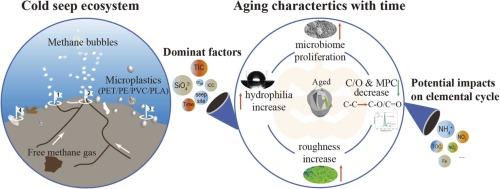Methane seepage leads to a specific microplastic aging process in the simulated cold seep environment
IF 12.2
1区 环境科学与生态学
Q1 ENGINEERING, ENVIRONMENTAL
引用次数: 0
Abstract
Marine microplastics pose a significant threat to ecosystems, and deep-sea regions serve as critical sinks for these pollutants. Among these regions, cold seeps harbor relatively high concentrations of microplastics. However, research on the aging of microplastics under low-temperature, dark, methane-abundant, and high-pressure conditions remains limited. Seawater and sediment were collected from various Haima cold seepage sites to simulate seepage environments in 200-mL high-pressure reactors. Four types of microplastics at high concentrations (approximately 10 %) were cultured and monitored over two months to explore how they aged. The key findings are as follows: (1) Compared to areas of weak seepage, methane seepage accelerated microplastic aging, as evidenced by increased surface roughness, enhanced C-O and (C![]() O)-O bond formation, increased microbial colonization, and reduced contact angles. (2) Microplastic aging is more pronounced in sediments than in seawater, with biodegradable polylactic acid (PLA) exhibiting the most significant aging characteristics and carbon contribution. (3) Aged microplastics induce greater disturbances in inorganic nutrient levels than in organic matter, impacting nitrogen cycle processes involving nitrate, nitrite, and ammonium. This study results reveal the fundamental aging characteristics of microplastics in extremely deep seas and highlight their potential ecological effects.
O)-O bond formation, increased microbial colonization, and reduced contact angles. (2) Microplastic aging is more pronounced in sediments than in seawater, with biodegradable polylactic acid (PLA) exhibiting the most significant aging characteristics and carbon contribution. (3) Aged microplastics induce greater disturbances in inorganic nutrient levels than in organic matter, impacting nitrogen cycle processes involving nitrate, nitrite, and ammonium. This study results reveal the fundamental aging characteristics of microplastics in extremely deep seas and highlight their potential ecological effects.

甲烷渗漏导致模拟冷渗漏环境中特定的微塑料老化过程
海洋微塑料对生态系统构成重大威胁,而深海区域则是这些污染物的重要汇集地。在这些区域中,冷渗漏区的微塑料浓度相对较高。然而,有关微塑料在低温、黑暗、甲烷丰富和高压条件下老化的研究仍然有限。从不同的海马冷渗漏点收集海水和沉积物,模拟 200 毫升高压反应器中的渗漏环境。培养了四种高浓度(约 10% 左右)的微塑料,并对其进行了两个月的监测,以探索它们的老化过程。主要发现如下(1) 与弱渗流区域相比,甲烷渗流加速了微塑料的老化,表现为表面粗糙度增加、C-O 和 (C=O)-O 键形成增强、微生物定植增加以及接触角减小。(2)微塑料在沉积物中的老化比在海水中更明显,可生物降解的聚乳酸(PLA)表现出最显著的老化特征和碳贡献。(3) 与有机物相比,老化的微塑料会对无机营养物水平造成更大的干扰,从而影响涉及硝酸盐、亚硝酸盐和铵的氮循环过程。该研究结果揭示了微塑料在极深海中的基本老化特征,并强调了其潜在的生态效应。
本文章由计算机程序翻译,如有差异,请以英文原文为准。
求助全文
约1分钟内获得全文
求助全文
来源期刊

Journal of Hazardous Materials
工程技术-工程:环境
CiteScore
25.40
自引率
5.90%
发文量
3059
审稿时长
58 days
期刊介绍:
The Journal of Hazardous Materials serves as a global platform for promoting cutting-edge research in the field of Environmental Science and Engineering. Our publication features a wide range of articles, including full-length research papers, review articles, and perspectives, with the aim of enhancing our understanding of the dangers and risks associated with various materials concerning public health and the environment. It is important to note that the term "environmental contaminants" refers specifically to substances that pose hazardous effects through contamination, while excluding those that do not have such impacts on the environment or human health. Moreover, we emphasize the distinction between wastes and hazardous materials in order to provide further clarity on the scope of the journal. We have a keen interest in exploring specific compounds and microbial agents that have adverse effects on the environment.
 求助内容:
求助内容: 应助结果提醒方式:
应助结果提醒方式:


